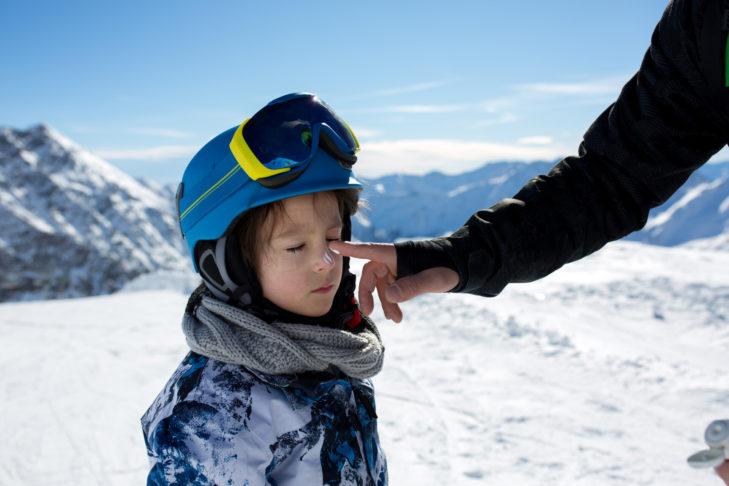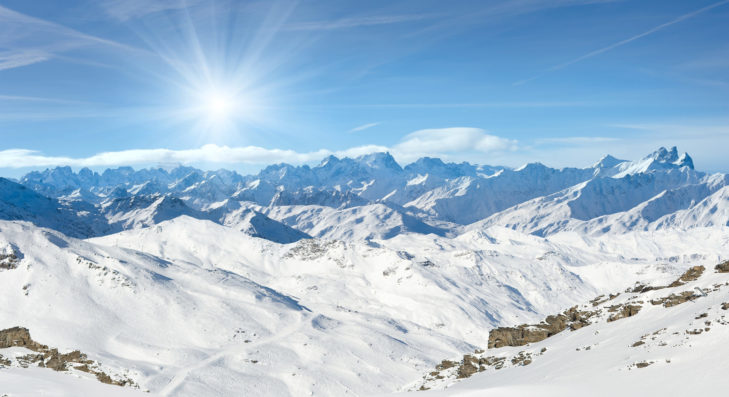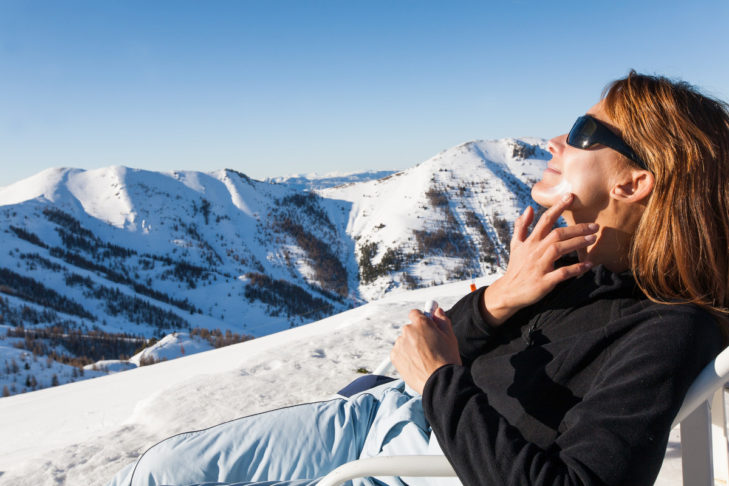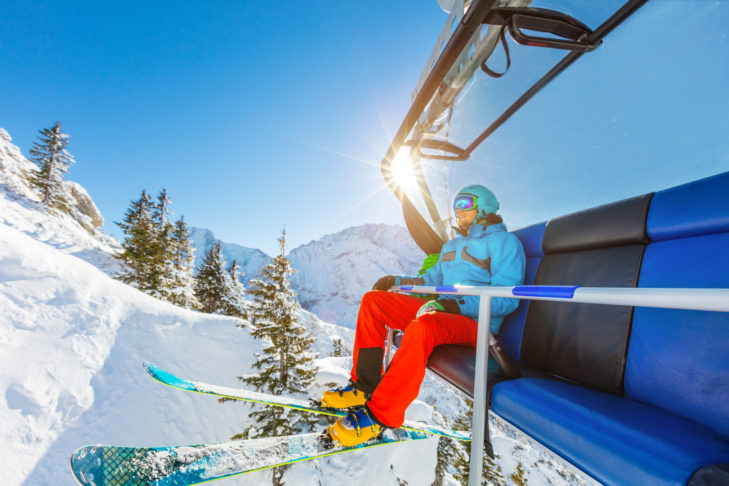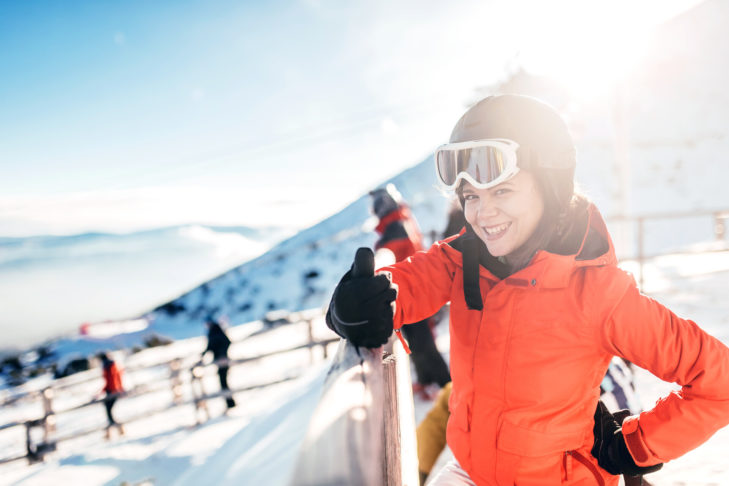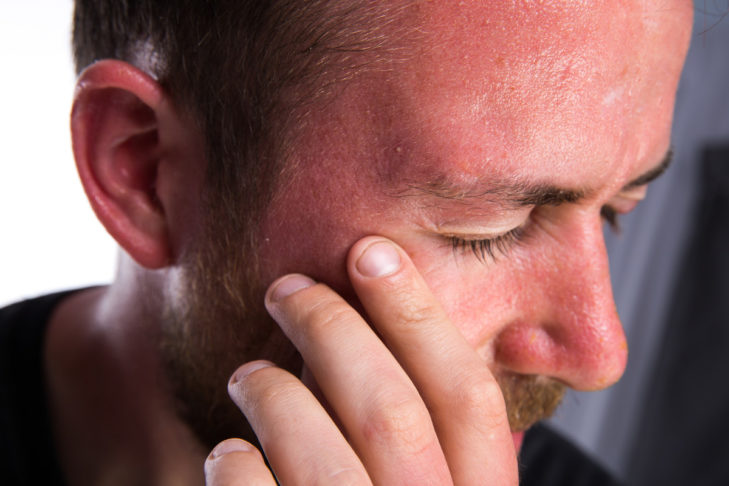Mountain peaks are as white as powdered sugar, sunshine beaming down from the sky and glistening snow – these are the ideal conditions for winter sports fans. However, this is precisely where skiers expose themselves to an often-forgotten danger: sunburn. While many only pay attention to sun protection at the beach or while swimming, it is also very important when in the snow and on the slopes. Long days on the mountain, glacier sun and high-altitude ski areas cause particular strain on the skin and eyes. SnowTrex spoke to sun protection expert and SWOX CEO Maximilian Jagsch and asked him about his top tips for UV protection on the mountain.
This is why sun protection is so important while skiing
The decisive factor is that skiing brings you closer to the sun than the beach. This is because the higher you are on the mountain, the smaller the protective layer of the atmosphere becomes. This means that fewer UV rays are filtered out and thus more rays hit the skin. So, the higher you go, the more radiation you are exposed to. In addition, the winter sun is reflected onto the skin via the white snow, so not only are you being hit by UV rays from above, but also from below or from the side.
When skiing, the so-called “sun terraces” on your body are particularly at risk: the bridge of the nose, eye areas, cheeks, ears, lips as well as the scalp, hairline and crown of the head need special protection when skiing. The same applies to the skin and especially to the eyes.
Tip 1: Extra waterproof sunscreen
Although you are not directly in the water when skiing, an extra waterproof sunscreen still offers the best protection. Sweat, wet snow as well as damp clothing and gloves are enough to make regular sunscreen almost ineffective. Maximilian Jagsch has another insider tip: “If you are looking for sunscreen that offers optimal protection for the face and body even beyond the sun-skiing days, look for the label ‘extra waterproof’ when buying it.”
Tip 2: Early application
If you protect yourself professionally against painful sunburn, skin cancer and premature skin ageing, you can enjoy the spring months in the mountains. Light sunscreens take about thirty minutes for their active ingredients to be absorbed into the skin and develop their full protection. To avoid forgetting particularly sensitive areas of the skin, such as the ears or neck, it is best to apply UV protection at home or in the car – without a hat, glasses or jacket.
Tip 3: Reapply after at least 2 hours
Sun protection expert Maximilian Jagsch recommends topping up every 1.5 to 2 hours. This maintains the sun protection, but does not prolong it. This is approximately the time after which the active ingredients lose their full protection or often part of the sun protection is lost due to friction. The decisive factor for calculating how long one should stay in the sun is always the beginning of the day outside and not the moment of reapplication.
Tip 4: Mineral sunscreen
While early application is essential for sunscreens, mineral sunscreens work immediately after application. In the past, the products were often tough and difficult to apply. However, the latest generation of mineral sunscreens, e.g. SWOX Performance Zinc, is almost indistinguishable from normal sunscreen when applied. Mineral sunscreen does not work in the skin, but on the skin, reflecting the sun’s dangerous rays. Titanium or zinc particles act like small mirrors, thereby preventing penetration into the skin.
Tip 5: Choice of sun protection factor (SPF)
The sun protection factor (SPF) indicates how much the skin’s own protection time is extended by applying sunscreen. The SPF value of a product depends not only on the skin type, but also on where and for which occasion it is used. When skiing and particularly in spring, for example, a sunscreen with a sun protection factor of at least 30 should be used. Maximilian Jagsch adds: “Broad-spectrum protection is just as important as the sun protection factor. You should pay particular attention to this when buying sunscreen as it protects against the UV-B rays that cause skin cancer”.
Tip 6: Sunscreen for sensitive skin
Sensitive skin and skin prone to allergic reactions needs special UV protection. In addition, many athletes prefer fragrance-free sunscreens that do not cause skin reactions, especially while sweating. The keyword here is hypoallergenic sunscreen. Natural sunscreens and mineral sunscreens of this type contain no perfume, no parabens and no alcohol.
Tip 7: How much sunscreen to apply?
Sun protection expert Maximilian Jagsch says: “Most people use far too little sunscreen. This is a problem because the sun protection factor of a sunscreen is measured with the best possible distribution and sufficient product usage. If you apply less, there is not enough UV protection.” For the face and neck area, dermatologists recommend applying at least one tablespoon of sunscreen while skiing.
Tip 8: The best protection – avoid intense exposure to the sun
The sun is strongest during the midday hours. However, these are difficult to avoid completely while skiing. It is therefore important, even in warm spring weather, to cover the areas of the skin that are particularly exposed when skiing with clothing. A helmet or a thin fabric cap protects the sensitive scalp. In addition, ski goggles are an eye-friendly alternative to sunglasses. The back of the neck can be protected with a thin multifunctional scarf or tube scarf.
Extra tip: The right sun protection for your eyes while skiing
The eyes are a very sensitive organ, just like our skin. That is why they must be given very special protection against UV-A, UV-B and UV-C rays. So how can we protect our eyes in the best possible way?
Normal sunglasses are not sufficient as adequate protection for the eyes when skiing – even though many skiers use them. As previously mentioned, the sun’s rays are reflected by the snow. Sunglasses only offer protection when the sun’s rays hit the lenses directly. Rays that shine on the eyes from all sides, however, are not filtered by normal sunglasses. For safe, all-round protection, you should wear proper ski goggles as they provide your eyes with the optimum protection they absolutely need.
There are different lens colours for ski goggles: mirrored lenses are recommended as they offer skiers the best protection as they block the glare. However, they should not be used in darker light conditions – for example in fog, snowfall or poor visibility. On the other hand, bright lenses such as yellow or pink are perfect for poor visibility.
When choosing the right goggles, it’s important not to go primarily by looks. Even if ordinary sunglasses look a bit more casual, it can quickly become dangerous for the eyes in combination with the cold temperatures, the bright environment and the UV radiation. Moreover, ski goggles should be able to do more than just protect you from the sun: For example, they also need shatterproof glass, as they are exposed to extreme forces if they fall on your face. Sunglasses can also break much more easily than proper ski goggles, thus becoming an enormous danger to the eyes.
Therefore: Get detailed advice from a specialist shop and check the ski goggles carefully for a good fit. In addition, use a system that allows you to use different lenses depending on the current weather conditions and don’t cut corners for your own safety.
Sunburn while skiing – now what?
If you didn’t apply your sunscreen properly, or you simply forgot to do so and the result is sunburn, you should follow these steps:
1. Please avoid the sun at all costs! In the event of sunburn, the skin must always be protected from further exposure to the sun. So, it’s better to cover up with clothing or take a break for a day.
2. As soon as the skin blisters or symptoms such as fever and nausea appear, a doctor must be consulted immediately. Not only may severe burns have occurred, but also sunstroke. Here, an expert opinion is imperative.
3. After consulting a doctor or the pharmacy, a skin-soothing cream should be applied to the affected areas. There are doctors and pharmacies in just about every ski resort who will know what to do.
4. Regardless of the treatment, the affected skin needs to be cooled. Caution: Do not put ice directly on the skin (can lead to frostbite), but apply cold compresses instead. The treatment is no different from that for sunburn in summer.
5. Dehydrated skin can be greatly helped by moisturising it from the inside as well. So be sure to drink plenty of fluids – preferably water, of course. Incidentally, you should not forget to drink while skiing in general, even if you have the feeling that you are not sweating that much.
FAQs on sun protection while skiing
Which sunscreen is suitable for skiing?
It is best to use a sunscreen with a sun protection factor of 20 or higher. It should be waterproof and have a high fat content.
Can every person use the same sun protection factor?
No, depending on your skin type, you need a higher factor. It is best to ask your dermatologist. Generally speaking, the lighter the skin, the more susceptible it is.
Is it enough to put sunscreen on the face?
All areas that are exposed to the sun’s rays must be covered with sunscreen while skiing: this may include the back of the neck, the ears, the hands or the arms (depending on the clothing), for example. The mouth area is also important: compared to other areas, the skin on your lips is particularly thin. A special lip balm with a sun protection factor offers the best protection against dehydration and sunburn. Because of how thin the skin is, you should apply the lip balm 45 to 60 minutes before the ski day and reapply it more often than for the rest of your body.
Do I have to put sunscreen on if I’m only on the mountain for a short time and go straight back down?
Even then, sun protection is very important. The higher the mountain, the stronger the radiation exposure, with a corresponding increase in the risk of sunburn. The amount of time you spend on the mountain is irrelevant.
Can I go on the pistes as usual despite sunburn?
Sunburn should not be taken lightly and any affected areas of the skin should no longer come into contact with the sun’s rays. If the skin overheats, it can also lead to sunstroke or severe burns. So, stay out of the sun and, if necessary, have your skin checked by a doctor first!
Are sunglasses enough to protect the eyes?
Ordinary sunglasses do not offer all-round protection for the eyes and are also not stable in the event of a fall. Proper ski goggles, on the other hand, offer this protection.
How do I prevent my ski goggles from fogging up?
Fogged lenses can quickly become dangerous on the piste. Ideally, the humid air is automatically led outside through ventilation openings. However, if these slits are covered, the moist air collects inside and the lenses fog up. Goggles with an anti-fog coating fog up less. Winter sports fans should also pay attention to the following: Ski goggles should not fit too tightly on the head. If possible, do not cover ventilation slits with hats or scarves. If you wear a helmet, you can avoid this and also protect your head! Dry the ski goggles in the air and not on the head, because the head gives off heat. Do not wipe the goggles, as this can damage the coating. Ski goggles should be double glazed (anti-fog and accident protection).
Are there any tips to consider when buying ski goggles?
A perfect fit is particularly important: the goggles should not be too small or too large. It is best to always check the ski goggles for a good fit with a helmet (and, if necessary, with normal vision goggles). Goggles that adapt to the weather conditions are ideal, but if they’re too expensive, you can use goggles with interchangeable lenses.
How do I clean my ski goggles correctly?
In order to avoid damaging the coating of the lenses, ski goggles should only be cleaned with water and a microfibre cloth. It is important that you always store your ski goggles in the appropriate case to protect them from scratches.

